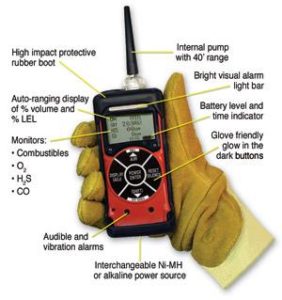Purpose
The Authorised Gas Tester’s role is critical in testing for and ensuring safe working atmospheres, in particular: permit controlled confined spaces, and prior to and during hot work for both open and enclosed spaces. It will enable one to read and interpret correctly information as obtained from the gas detection means available.
Target Audience
Safety Officer, Deck officers, Management Level Officers who would like to be Authorised Gas Tester.
Course Content
AGT – Module 1 – Authorised Gas Tester
(1) Confined space criteria
(2) The type of operations being tested for flammable and toxic gases
(3) The hazards of operations within an oxygen-enriched, oxygen-deficient, toxic or flammable environment
(4) Carrying out a suitable and sufficient risk assessments
(5) Understand the safe systems of work, how to work within the safe system of work and the associated responsibilities
(6) The implications of statutory and organisational requirements
(7) Interpreting operational requirements
(8) How to select, use and care for PPE and RPE
(9) Accessing and interpreting operational instructions
(10) The operating principles of atmosphere monitoring and measuring equipment and failure modes
(11) The strengths and weaknesses of various types of atmospheric flammable and toxic gas detection equipment
(12) Correct selection of aspirating or non-aspirating detectors to obtaining representative atmosphere sample
(13) Equipment required for testing for hydrocarbons in inert atmospheres
(14) Gas detector pre-start checks
(15) Determining the extent of the test boundaries
(16) Calibrating the instruments used in atmospheric testing
(17) Sources of assistance during the event of damaged or defective equipment
(18) Interpreting normal and abnormal results
(19) Documenting the results and advising relevant personnel
AGT – Module 2 – Testing for flammable gas in preparation for hot work
(1) Hot work (any operation involving naked flames or producing heat and/or sparks or any operation that has spark potential)
(2) Type of operations being tested for flammable and toxic gases
(3) The principles of hot work gas testing
(4) The hazards and properties of flammable gases
(5) Acceptable levels of flammable gases and the correct amount of oxygen
(6) Carrying out a suitable and sufficient risk assessment
(7) Using safe systems of work and understanding the associated responsibilities
(8) The implications of organisational and statutory requirements
(9) Detectors used for the flammable product
(10) How to set up the relevant detectors for each gas testing application and confirm functioning correctly
(11) The range and frequency of tests and monitoring and retesting requirements
(12) Where to site portable or transportable equipment that will be used to continuously monitor the atmosphere
AGT – Module 3 – Confined Space Testing
(1) The hazards and properties of flammable and toxic gases
(2) The behaviour of different gases
(3) The range and frequency of tests and monitoring and retesting requirements after initial entry
(4) Acceptable levels of flammable gases and the correct amount of oxygen
(5) The implications of WEL for toxic gases and LEL for flammable gases
(6) How to set up the relevant detectors for each gas testing application and confirm functioning correctly
(7) Performing Gas tests in sequential order
(8) How to obtain representative atmosphere sample
(9) Taking various samples to locate varying concentrations of gases and vapors
(10) Importance of sampling confined spaces at a distance
(11) Testing flammable gases in inert atmospheres
(12) Where to site portable or transportable equipment that will be used to continuously monitor the atmosphere
AGT – Module 4 – Gas Monitoring for Hotwork Sites
(1) Hot work (any operation involving naked flames or producing heat and/or sparks or any operation that has spark potential)
(2) Confined space criteria
(3) The type of operations being tested for flammable and toxic gases
(4) Roles and responsibilities of the Fire Watch
(5) Roles and responsibilities of the Stand By person
(6) Responsibilities of the Gas Monitor role
(7) How to select, use and care for PPE
(8) How to work within the safe system of work
(9) The hazards and properties of flammable gases
(10) The behaviour of different flammable and toxic gases
(11) The potential arrival of flammable gas or vapour clouds at the hot work site
(12) Impact of environmental changes on working conditions
(13) Importance of checking controls on the equipment are as specified
(14) Importance of regular communication
(15) Sources of assistance and specialist support
(16) Completion of relevant documentation
GMT – MODULE 1 Gas Monitoring for Hotwork Sites
(1) Hot work (any operation involving naked flames or producing heat and/or sparks or any operation that has spark potential)
(2) Confined space criteria
(3) The type of operations being tested for flammable and toxic gases
(4) Roles and responsibilities of the Fire Watch
(5) Roles and responsibilities of the Stand By person
(6) Responsibilities of the Gas Monitor role
(7) How to select, use and care for PPE
(8) How to work within the safe system of work
(9) The hazards and properties of flammable gases
(10) The behaviour of different flammable and toxic gases
(11) The potential arrival of flammable gas or vapour clouds at the hot work site
(12) Impact of environmental changes on working conditions
(13) Importance of checking controls on the equipment are as specified
(14) Importance of regular communication
(15) Sources of assistance and specialist support
(16) Completion of relevant documentation
| Course | Fee INR | Duration | Course Timing | Date Commence | Remarks |
|---|---|---|---|---|---|
| AGT | 10,000 | 1 day | 10:00-18:00 | On Demand | |
| GMT | 10,000 | 1 day | 10:00-18:00 | On Demand | |
| GAS FREE | 10,000 | 1 day | 10:00-18:00 | On Demand |

